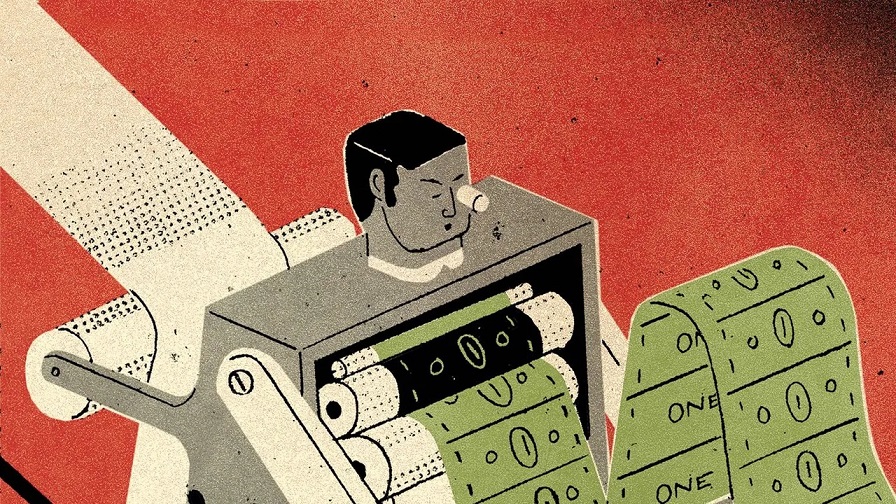Economy
Can Printing More Money Make Poor Nations Richer?

It seldom works when an entire country attempts to get wealthy by creating more money. Everyone has more money, thus prices will rise. And individuals are finding that they need more and more money to buy the same number of products as they did in the previous years.
As a result of the recent printing of additional money in Zimbabwe and Venezuela in South America, both nations’ economies grew.
Due to increased printing, prices began to rise at an alarming rate and these nations began to experience “hyperinflation.” It’s at this point when costs skyrocket.
During Zimbabwe’s 2008 hyperinflation, prices increased by 231,000,000% in one year. Imagine that a candy that cost one Zimbabwe dollar before inflation now costs 231 million Zimbabwean dollars.
Considering the amount of paper used, it’s likely that the banknotes printed on it are worth more.
For a country to get wealthy, it must produce and sell more products and services. Printing additional money for people to buy those extra items is now secure.
A country’s prices will rise if it prints more money without producing more goods. Those old Star Wars toys from the 1970s, for example, can be quite valuable.
These models are no longer produced. As a result of this, the vendors will just raise their prices.
Only one country can become richer by printing more money at the present, and that’s the United States of America (a country that is already very wealthy).
Most precious commodities, such as gold and oil, are valued in US dollars. The main idea behind this is that the US dollar is a more stable currency than other country’s national currencies.
That’s because investors and those people who are involved in the Forex market are investing more money in USD.
In order to learn more about the dollar and the reasons why traders invest more money in the mentioned currency, you need to understand the meaning of bid price in Forex, which is one of the commonly used terms in Forex trading.
The bid price shows the dealer’s willingness to pay for the asset, whereas the dealer’s willingness to sell it is the asking price. As the dollar can be used, like gold, to hedge against inflation, many investors are ready to pay a certain amount of money. That amount of money is also known as, as already mentioned, bid price.
If the United States wishes to buy more items, it can simply create more dollars to do so.
Rather, consumers will trade items for other goods, or seek to be compensated in US dollars in lieu of foreign currency. In Zimbabwe and Venezuela, as well as in many other nations, hyperinflation took place.
For example, Venezuela enacted regulations to keep food and medical prices low to safeguard its people from hyperinflation. The stores and pharmacies just ran out of such items.
While a country cannot get wealthy by creating money, this is not true. Money shortages prevent firms from selling enough or paying all their employees. Even banks are unable to lend money because people do not have any.
When more money is printed, individuals can spend more, which allows firms to create more, resulting in more items to buy, and more money to buy them with.
During the global financial crisis of 2008, banks lost a lot of money and were unable to give it to their clients. To their advantage, most nations have central banks, which assist to manage the other banks, and they issue more money to get their economies back on track again.
Prices fall because there is not enough money, which is a terrible thing. But when there isn’t greater output, printing more money causes prices to rise, which may be just as terrible. “Dismal science” has been used to describe economics – the study of money, commerce, and business.
Problems Caused by Printing More Money
Poor countries could not get wealthy by printing additional currency. This is known as “Inflation”. If you believe that the issuing government will not fail, then your currency has value. In the past, the United States currency was a “gold standard”. A dollar was no longer merely a piece of paper; it could be exchanged for its equivalent value in gold. Having abandoned that standard, our currency is depreciating in value as they create more money.
Consequently, inflation will skyrocket and the value of money will plummet. It’s simple to suggest that we can create more money and grow affluent, but in reality, the country will become even poorer as a result of this strategy.
Everyone knows what occurred to Zimbabwe as a result of the election results. One loaf of bread or one egg costs a lot of money. Each egg cost them $1,000,000 Zimbabwean dollars. To borrow money from the World Bank is always preferable to creating money, which will lead to a huge economic catastrophe.
Lots of money doesn’t necessarily translate into a lot of wealth, and vice versa. Economics depends on human needs, which are inexhaustible; everyone has something they want. There are, however, limitations to desires due to limiting resources like labour.
The price of milk and sugar, for example, has skyrocketed, now costing thousands of dollars instead of its regular price, if everyone was a billionaire; therefore, millionaires would spend hundreds of thousands for someone to mow their lawns.
Not money, but wealth, is what needs to be increased. A country’s economy can flourish by increasing the number of finite resources it possesses, such as labour. For example, China’s economy flourished as wealth was produced.
Global governments have spent billions in response to the COVID-19 epidemic this year — billions that many politicians argued nations didn’t have or couldn’t afford before the pandemic hit.
To pay for their policies, why can’t governments merely print money?
Inflation is the quick answer.
It’s been proven time and time again that when governments create money, prices rise because there are too many resources competing for too few commodities. Many people find that they can no longer purchase basic necessities since their salaries are rapidly devalued.
According to some estimates, monthly inflation in Zimbabwe throughout the 2000s surpassed 80 billion %. In the end, the native currency was replaced with the US dollar.
For example, in Germany during the 1920s, people were seen wheelbarrowing cash to stores to pay for basic necessities. Although the spiralling costs at the time had more to do with the punitive reparations payments than with money printing, it nevertheless shows the issue well.
In addition to this, governments cannot simply create additional money to pay off debt and fund spending since they are not in command of the money printing process.
Central banks, such as the US Federal Reserve, the Bank of England, and the European Central Bank, are in charge of regulating the money supply in most industrialized countries. However, central banks are autonomous of the government, even if they occasionally work together.
A decade ago, central banks printed billions through quantitative easing, which was intended to stimulate the economy.
Because they’re purchasing debt, central banks are freeing up capital that may be used for other purposes, such as investing in businesses or innovative technologies.
Central bankers, on the other hand, are solely concerned with the health of the economy and not with larger government issues like defence, education, and healthcare.
The central bank’s direct financing of the government might also cause international investors to lose faith in a country’s economy. To measure the size of an economy, money supply and exchange rates are used. Isn’t it almost like a snake devouring its own tail if central banks are just pumping out more money to pay off debt? As a result, a country’s currency value would plummet, making everyone in the country worse off.
Is Inflation Bad?
Depending on who you ask, inflation may be a sign of a failing economy or one of prosperity. It’s basically simply a new way of describing what inflation is. Due to a rise in prices, inflation reduces the buying power of cash. In the early years, a cup of coffee was priced at several cents. In today’s market, the price is closer to $3.
An increase in coffee’s popularity, price pooling by coffee growers, or years of catastrophic drought, flooding, or violence in a key growing region might all have contributed to a price increase. Prices of coffee goods would go up in these situations, while the rest of the economy would remain relatively the same. However, in this case, only the most caffeine-addled customers would see a considerable decrease in purchasing power.
There is a well-known pattern of people buying more now rather than later when their purchasing power declines. For this reason, it is best to get your shopping done early and stock up on items that are unlikely to depreciate in value.
Consumers must fill up their petrol tanks, stock their freezers, buy shoes for their children in the next size up, and so on and so forth. As a result, firms must make capital investments that, under other conditions, could have been put off until a later time. However, the short-term volatility of these assets might negate the benefits of being protected against price increases.
A surplus of cash is created as consumers and companies spend faster in an effort to decrease the amount of time they retain their depreciating money. So, as the supply of money increases, so too does the demand for it, and the price of money—the buying power of currency—declines at an ever-increasing rate.”
Hoarding takes over when things become truly bad, and grocery store shelves are left bare as a result. In a state of desperation to get rid of their cash, people spend their paychecks on everything they can get their hands on – as long as it’s not dwindling in value.
Using monetary policy, the U.S. government has managed inflation for the last century. The Federal Reserve (the U.S. central bank) relies on the connection between inflation and interest rates in order to accomplish its job. For example, corporations and individuals can borrow inexpensively to establish a business, get an education, recruit new employees or buy a beautiful new boat. In other words, low interest rates stimulate consumers to spend and invest, which in turn tends to fuel inflation.
It is possible for central banks to dampen these animal spirits by boosting interest rates. That boat’s or that company’s monthly payments look a bit excessive now, don’t they? In general, central banks do not want money to grow more valuable, as they dread deflation almost as much as they fear hyperinflation, despite the fact that scarcity enhances its worth. If inflation is to be kept at a target level, they will pull the interest rates in either way (generally 2 per cent in developed economies and 3 per cent to 4 per cent in emerging ones).
The money supply is another method to look at central banks’ involvement in managing inflation. Inflation occurs when the amount of money grows faster than economic growth. To pay for its World War I reparations, Weimar Germany revved up the printing presses, much as Habsburg Spain did in the 16th century with Aztec and Inca gold.
It’s not uncommon for central banks to boost interest rates by selling government bonds and removing the revenues from the money supply.
With no central bank or central bankers who are accountable to elected governments, borrowing rates will often be lowered by inflation
Let’s say you borrow $1,000 at a 5% yearly interest rate. A 10 per cent increase in inflation means that your debt’s real worth decreases faster than the interest and principal you’re paying off combined. A high amount of household debt encourages politicians to print money, fueling inflation and discharging voters’ debts. Because of this, politicians are considerably more motivated to create money and use it to pay off debt if the government is highly indebted.
Even though the Federal Reserve is mandated by law to promote maximum employment and stable prices, it does not need legislative or presidential approval to set interest rates. That does not mean, however, that the Fed has always had a free hand when it comes to policymaking. According to Narayana Kocherlakota, the former Minneapolis Fed president, the Fed’s independence is “a post-1979 phenomenon that relies primarily on the president’s discretion.”
Unemployment can be reduced by inflation, as evidenced by a few studies. It is common for wages to be “sticky,” meaning that they do not respond quickly to economic developments. According to John Maynard Keynes, the Great Depression was a result of wage stagnation. Because workers rejected salary cutbacks and were dismissed instead, unemployment soared (the ultimate pay cut).
If inflation reaches a particular level, businesses’ real payroll expenses decline, allowing them to recruit additional workers.
Economy
NBA Demands Suspension of Controversial Tax Laws

By Modupe Gbadeyanka
The federal government has been asked by the Nigerian Bar Association (NBA) to suspend the implementation of the controversial tax laws.
In a reaction to the tax reform acts, the president of the group, Mr Afam Osigwe (SAN), the suspension of the laws would allow for a proper investigation into allegations of alterations in the gazetted and harmonised copies.
A member of the House of Representatives, Mr Abdussamad Dasuki, alleged that some parts of the laws passed by the parliament were different from the gazetted copy.
To address the issues raised, the NBA said it is “imperative that a comprehensive, open, and transparent investigation be conducted to clarify the circumstances surrounding the enactment of the laws and to restore public confidence in the legislative process.”
“Until these issues are fully examined and resolved, all plans for the implementation of the Tax Reform Acts should be immediately suspended,” the association declared.
It noted that the controversies “raise grave concerns about the integrity, transparency, and credibility of Nigeria’s legislative process.”
“These developments strike at the very heart of constitutional governance and call into question the procedural sanctity that must attend lawmaking in a democratic society,” it noted.
“Legal and policy uncertainty of this magnitude has far-reaching consequences. It unsettles the business environment, erodes investor confidence, and creates unpredictability for individuals, businesses, and institutions required to comply with the law. Such uncertainty is inimical to economic stability and should have no place in a system governed by the rule of law.
“Nigeria’s constitutional democracy demands that laws, especially those with profound economic and social implications, emerge from processes that are transparent, accountable, and beyond reproach. Anything short of this undermines public trust and weakens the foundation upon which lawful governance rests.
“We therefore call on all relevant authorities to act swiftly and responsibly in addressing this controversy, in the overriding interest of constitutional order, economic stability, and the preservation of the rule of law,” the organisation stated.
Economy
MRS Oil, Two Others Raise NASD Bourse Higher by 0.52%

By Adedapo Adesanya
Demand for hot stocks, including MRS Oil Plc, buoyed the NASD Over-the-Counter (OTC) Securities Exchange by 0.52 per cent on Tuesday, December 23.
The energy company was one of the three price gainers for the session as it chalked up N19.69 to sell at N216.59 per share versus the previous day’s value of N196.90 per share.
Further, FrieslandCampina Wamco Nigeria Plc gained N2.95 to close at N56.75 per unit versus N53.80 per unit and Golden Capital Plc appreciated by 84 Kobo to N9.29 per share from Monday’s N8.45 per share.
Consequently, the market capitalisation went up by N10.95 billion to N2.125 trillion from N2.125 trillion and the NASD Unlisted Security Index (NSI) rose by 18.31 points to 3,570.37 points from 3,552.06 points.
Yesterday, the NASD bourse recorded a price loser, the Central Securities Clearing System Plc (CSCS), which gave up 17 Kobo to close at N33.70 per unit against the previous trading value of N33.87 per unit.
The volume of securities traded at the session went down by 97.6 per cent to 297,902 units from the previous day’s 12.6 million units, the value of securities decreased by 98.5 per cent to N10.5 million from N713.6 million, and the number of deals remained flat at 32 deals.
By value, Infrastructure Credit Guarantee Company (InfraCredit) Plc ended as the most actively traded stock on a year-to-date basis with 5.8 billion units exchanged for N16.4 billion. This was followed by Okitipupa Plc, which traded 178.9 million units valued at N9.5 billion, and MRS Oil Plc with 36.1 million units worth N4.9 billion.
In terms of volume, also on a year-to-date basis, InfraCredit Plc led the chart with a turnover of 5.8 billion units traded for N16.4 billion. Industrial and General Insurance (IGI) Plc ranked second with 1.2 billion units sold for N420.7 million, while Impresit Bakolori Plc followed with the sale of 536.9 million units valued at N524.9 million.
Economy
NGX All-Share Index Soars to 153,354.13 points

By Dipo Olowookere
It was another bullish trading session for the Nigerian Exchange (NGX) Limited as it closed higher by 0.59 per cent on Tuesday.
The market further rallied due to continued interest in large and mid-cap stocks on the exchange by investors rebalancing their portfolios for the year-end.
Yesterday, Aluminium Extrusion sustained its upward trajectory after it further appreciated by 9.96 per cent to N14.90, as Austin Laz gained 9.81 per cent to close at N2.91, Custodian Investment improved by 9.69 per cent to N38.50, and First Holdco soared by 9.35 per cent to N50.30.
Conversely, Royal Exchange declined by 7.22 per cent to N1.80, Champion Breweries shrank by 6.57 per cent to N15.65, NASCON lost 5.36 per cent to trade at N105.05, Sovereign Trust Insurance depreciated by 5.28 per cent to N3.77, and Japaul went down by 4.51 per cent to N2.33.
At the close of business, 29 shares ended on the gainers’ table and 27 shares finished on the losers’ log, representing a positive market breadth index and bullish investor sentiment.
This raised the All-Share Index (ASI) by 895.06 points to 153,354.13 points from 152,459.07 points and lifted the market capitalisation by N579 billion to N97.772 trillion from the previous day’s N97.193 trillion.
VFD Group finished the day as the busiest stock after it recorded a turnover of 192.0 million units worth N2.1 billion, GTCO exchanged 63.5 million units valued at N5.6 billion, Access Holdings traded 49.8 million units for N1.0 billion, First Holdco sold 45.8 million units valued at N2.3 billion, and Secure Electronic Technology transacted 38.3 million units worth N28.4 million.
In all, market participants bought and sold 677.4 million units valued at N20.8 billion in 27,589 deals compared with the 451.5 million units worth N13.0 billion traded in 33,327 deals on Monday, showing an improvement in the trading volume and value by 50.03 per cent and 60.00 per cent apiece, and a shortfall in the number of deals by 17.22 per cent.
-

 Feature/OPED6 years ago
Feature/OPED6 years agoDavos was Different this year
-
Travel/Tourism9 years ago
Lagos Seals Western Lodge Hotel In Ikorodu
-

 Showbiz3 years ago
Showbiz3 years agoEstranged Lover Releases Videos of Empress Njamah Bathing
-

 Banking8 years ago
Banking8 years agoSort Codes of GTBank Branches in Nigeria
-

 Economy3 years ago
Economy3 years agoSubsidy Removal: CNG at N130 Per Litre Cheaper Than Petrol—IPMAN
-

 Banking3 years ago
Banking3 years agoFirst Bank Announces Planned Downtime
-

 Banking3 years ago
Banking3 years agoSort Codes of UBA Branches in Nigeria
-

 Sports3 years ago
Sports3 years agoHighest Paid Nigerian Footballer – How Much Do Nigerian Footballers Earn













